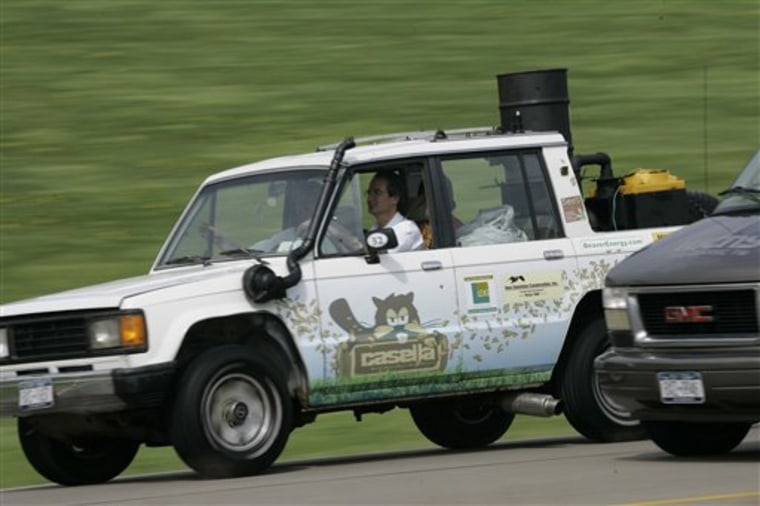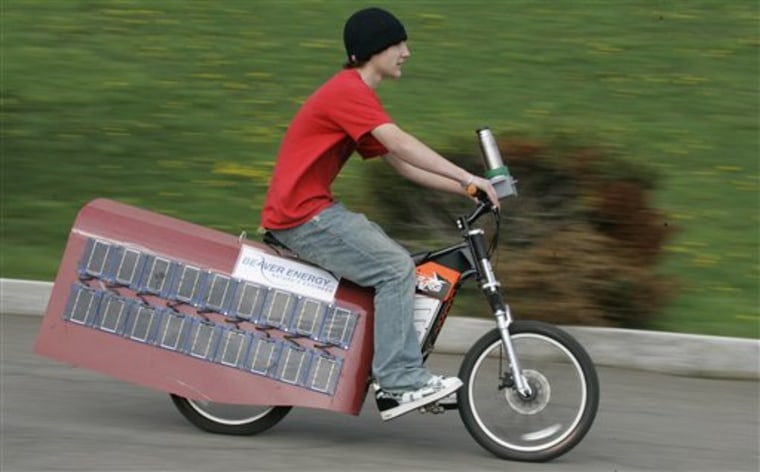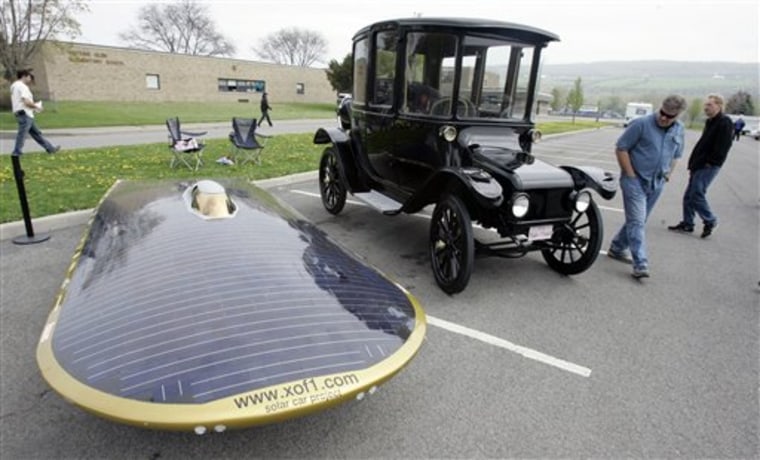When the green flag waved to start the Green Grand Prix of Watkins Glen, Robert Beam was out to smoke the field.
Literally.
His 1988 Isuzu Trooper was powered by wood chips in the only road rally for alternate-fuel vehicles and hybrids in the United States, sponsored by the Sports Car Club of America.
"We were going to have a wood-powered, supercharged Mercury Cougar XR-7 in it this year, but it's not ready," said Beam, whose nickname is, yes, "Chip."
As the price of gas continues to climb toward $4 a gallon, the event on May 3 attracted a record field of 46 cars — hybrid and flexible-fuel vehicles, hydrogen fuel cell cars, as well as some powered by biodiesel, electricity, liquid propane, compressed natural gas, even vegetable oil.
The goal: to preach energy independence, reduce greenhouse gases and educate the public about alternative fuels. It doesn't hurt to have a good time doing it at the place road racing came of age in America 60 years ago.
The rally is the brainchild of Bob Gillespie, a retired art teacher and lifelong car aficionado.
"There are more people buying hybrid cars and they're excited about them, but they didn't have a way to celebrate the technology," said Gillespie, who drives a 2005 Toyota Prius with 82,000 miles on it. "I was thinking these people deserve a sporting event of their own. So many people think these cars are efficient, but they're not fun to drive."
A mile on a pound of wood
Beam's contraption smells like a backed-up wood stove when he fires it up, and then is pretty much emission-free. Even though it has a top speed of only about 45 mph, Beam figures it goes about a mile on a pound of wood, which is pretty economical when you crunch the numbers. At $225 a cord around here — which can be about 4,000 pounds of wood — Beam could go around 4,000 miles. With gas at $3.75 a gallon, a car getting 25 miles to the gallon would use 160 gallons of gas worth $600.
The car holds 500 pounds of wood and he can tow a trailer with 2,000 pounds more, stopping once an hour (at 25 mph) to refuel.
At today's prices, that's as efficient as any hybrid on the road.
"People just go nuts when they see it," Beam said. "They just can't believe you can run a car on anything but what they're used to seeing. When we tell them we're running wood chips, they kind of get a feeling that there's some hope, that there's other people looking at alternative answers to high fuel costs."

Beam and partners Larry Shilling and Aron Lantz have formed a startup company, Beaver Energy, based in Williamsport, Pa., and hope to produce liquid fuel from wood waste and other organic materials for under a dollar a gallon. The Trooper just helps spread the word.
"It's definitely an obscure thing," Beam said.
Similar systems were used during World War II when gasoline was a precious commodity.
"The Germans didn't let any of their people have fuel because they needed it for the war machine, so they had to figure out another way to run their vehicles," said Beam, a specialist in computer-aided design and drawing. "They actually ran them on charcoal, which is kind of an expensive process. The system I've got actually turns wood into charcoal, and then turns it into hydrogen and carbon, which then runs in the car."
Recycling carbon dioxide
The core of the Isuzu's power plant is protected in a steel jacket because the temperature inside approaches 2,400 degrees, hot enough to turn any organic material into hydrogen and carbon.
"It all happens in the car," Beam said. "When the car's running, it's making fuel. We're not adding carbon dioxide to the atmosphere. We're just recycling it."
The only byproduct is the water vapor and a trace of carbon dioxide that come out the exhaust.
That's music to the ears of Gillespie, who counts conservation, innovation and education as hallmarks of the Green Grand Prix.
"It's a perpetual motion machine," Gillespie said. "We don't want him to cut down any trees, though."
Not to worry: The plan is to use the 7.5 million tons of wood waste generated in Pennsylvania each year. The partners also are seeking grants to build a plant to convert it and other organic material into liquid fuel.
Race has evolved in 4 years
The inaugural Green Grand Prix four years ago was a simple display of eight cars on the county courthouse lawn. It has morphed into a bona fide race in which competitors vie in two categories: fuel economy and the traditional scoring system used in SCCA rallies. When they start, the drivers and their navigators have no idea where they're headed. The event is on public roadways, and the whole point is to arrive at the finish line when you're supposed to — not too early and not too late — by obeying speed limits and not making any wrong turns.
"It's not just a parade of cars. It's a full competition, and they run a strenuous course," Gillespie said.

Two years ago, Tom Lyon of Carlsbad, Calif., won the miles-per-gallon category, averaging 76.1 in a 2000 Honda Insight over a 78-mile course around Seneca Lake, one of the Finger Lakes that stretch across the central part of New York.
Last year, competing against a field that included a 1908 Stanley Steamer, a Honda Accord hybrid sponsored by the IndyCar Series and a bright red 1934 Ford pickup truck propelled by liquid propane, Jory Squibb's Moonbeam Microcar had the best overall mileage of 100 miles on a gallon of gas.
Biodiesel motorbike takes top honors
On Saturday, a biodiesel-powered Harley-Davidson motorcycle ridden by New England Biodiesel founder Bill Bolch took top fuel honors at 89 miles per gallon, while a Chevrolet Equinox powered by a hydrogen fuel cell was second overall in the road rally.
Perhaps Gillespie's proudest moment came when six elementary schools — five from New York and the other from Salt Lake City — received awards for alternative fuel vehicle design in a contest limited to students from fourth through seventh grade.
"Ultimately, the goal of the Green Grand Prix is to encourage students that are interested in renewable energy and sustainable economy issues to pursue careers in those fields and stay in the Northeast," Gillespie said.
